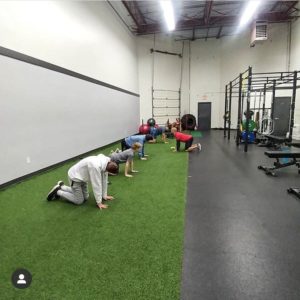By Guy Demong (CSCS, SFG I)
Within the last year or so, I’ve been reading a lot of articles by Dr. John Rusin (check out his site here), a physiotherapist/strength coach down in the US. One of the shorter e-books I came across was “6 Phases of the Perfect Dynamic Warm-Up“, and what I really enjoyed about this one, in particular, was that it gave me a different way of looking at how which to design warm-ups. I didn’t necessarily use his specific template or flow – but this wasn’t in an effort to be different, so much as it was that I wanted to apply some of my own critical thought and interpretation.
The first element I considered was “What is the primary goal of a warm-up”?. In my opinion, it should be used as preparation – physically and mentally – for the training session. Next was the recognition that there is definitive value in consistent and frequent practice – after all, doing something once or twice per week, while better than nothing, can take a long time to have a recognizable impact. I also took into account the fact that there continues to be a debate within the industry on the need for certain elements – things like “self-myofascial release” (aka foam rolling), or “glute activation”, etc.
In the end, I elected to utilize the following in all of my warm-ups:
- Self Myofascial Release – because although the jury is still out in terms of it’s efficacy, it certainly hasn’t shown to create an inherent risk. So what’s the harm in putting 3-4mins of it into the start of the session?
- Low Threshold General Range of Motion – starting with basic, ground-based movements before progressing into ones that require a more coordinated and focused approach
- An Integrated Full Body Movement Flow – finally, linking a series of more fundamental moves together that bring a range of motion and coordination into a dynamic and practiced pattern
I felt it would work best to keep the series of exercises consistent, rather than varying them every day (variety comes at other points in the training) – for all the clients I design a program for (and for myself), I use the same series of about 10-12 exercises before every training session. While there might be 1-2 exercises that differ based on experience and or the individual’s needs, they are pretty much the same all the way through. As a whole, I’ve found that there have been two significant benefits that have come from this: consistent repetition of certain fundamental movements, and (once the warm-up is memorized) an easy to implement a routine that makes daily practice a realistic possibility.
*It should be noted that I’ve structured these around three “levels”, and people will be given one of them based on their experience and abilities.
The most advanced warm-up looks something like this:
Soft Tissue
- Using a stick, a quick and fast “frisk” (that’s the best way to describe the movement) of about 10 motions on the following spots: calves, hamstrings, abductors, inner and outer quads. Then grab a lacrosse ball (or a more specific self-massage ball) and roll the bottom of the feet and glutes. Finish off with a series of short rolls paired with upper back extensions on a foam roller.
Ground-Based Range of Motion and Movement Preparation
- This is a simple, low-intensity series of exercises meant to build towards a more dynamic series of moves. It is the same general series and targets the same areas regardless of your experience level, though likely with a few individualized additions, subtractions, and modifications.
- Keep each movement “easy” – move lightly through them. Don’t move slowly, don’t “grind” to get more ROM – let the body ease into them.
-
- Bretzel x 3ea
- Open Books x 3ea
- Arm Sweep x 3ea
- Active Straight Leg Raise x 5ea
- Cross-Body Leg Drop x 5ea
- Dying Bug x 5ea
- Glute Bridge x 10
- Lateral Hip Rockers x 5ea
- Scorpion x 5ea
- Cat and Camel x 3ea
- Bird Dog x 5ea
- Frog Stretch x 5ea
Dynamic Integrated Movement
- This is a bit of an overly fancy title, but probably the best description, generally speaking. Once I’ve loosened up with the previous warm-up, I like to put it all together into a “flow”, or series of movements, that gets everything working together before heading into the more challenging section of the programming. This particular flow is fairly demanding from the perspective of balance and general mobility that’s needed to hit each of the movements – talk to your coach before trying this as shown.
- Move smoothly from one exercise to another once on one side, then transition to the other side. Repeat it in alternating fashion for 3-5x each.
-
- Spiderman Lunge
- Lunge with Overhead Rotation
- Toe Lift Hamstring Stretch
- Extended Lunge with Overhead Reach
- Cossack Squat
This whole process should only take about 10-12 minutes from start to finish, once you’ve learned it and can be used before any training session, game, or even as it’s own “mobility” workout on a recovery day.


